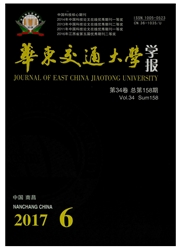

 中文摘要:
中文摘要:
通过对上海市轨道交通网络拓扑结构的分析,获得了基于L空间和P空间视角的轨道交通网络所具有的不同性质:在L空间下网络的度值相对较小,80%以上节点的度为2,度分布很集中,整个网络的平均最短路径反映了从任意站点到任意站点的实际需要通过的平均站点数,最短路径长度相对较大,网络的聚类系数很小,接近于0;而在P空间下,网络整体的度值很高,且分布区域也很广,而网络的平均最短路径很小,它反映的是从一个站点到任意一个站点平均需要换乘的次数,网络的聚类系数很大,超过了0.9,上海市轨道交通网络超过85%的节点的聚类系数为1。
 英文摘要:
英文摘要:
This paper firstly analyzes the network transfer mechanism between lines in the whole Shanghai mass transit network at macroscopic level. Then it discusses the topology structure for the whole mass transit network. It finds out that the network has different natures from the perspectives of Space L and Space P. In Space L, the values of net work degree are relatively smaller and the degree values of more than 80% nodes are less than 2 with concentrated distribution of degree values; the average shortest path of the entire network is the average value of actual station numbers in the path from any station to any station with relatively larger length of shortest path and small network clustering coefficient close to 0. In space P, the values of network degree are relatively larger with wide distribution of degree values; the length of the average network shortest path is relatively small-er, which indicates the average transfer times from a station to any station; the network clustering coefficient is very large, which is more than 0.9, and more than 85% nodes’ network clustering coefficients in Shanghai mass transit network are 1.
 同期刊论文项目
同期刊论文项目
 同项目期刊论文
同项目期刊论文
 期刊信息
期刊信息
